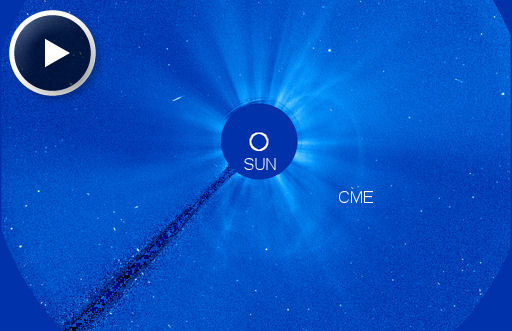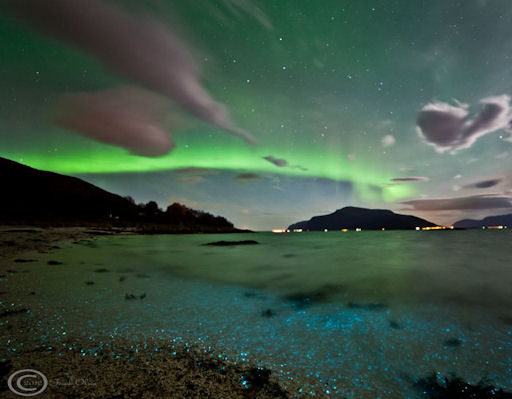ASTEROID FLYBY: Today, newly-discovered asteroid 2012 TV is flying through the Earth-Moon system about 2/3rd of the way between the Earth and the Moon. The 40m-wide space rock is glowing like a 13th-magnitude star, which makes it a good target for experienced amateur astronomers with mid-sized telescopes. [3D orbit] [details]
DRACONID METEOR SHOWER: The notoroiusly unpredictable Draconid meteor shower peaks this year on the night of Oct. 7-8. In most years, the Draconids come and go with a barely noticable peak of 10 or so meteors per hour. Occasionally, however, Earth passes through a dense clump of debris from parent comet 21P/Giacobini-Zinner and a meteor storm erupts. Just last year, Europeans witnessed a faint but furious outburst of 600 per hour. There is no reason to believe that 2012 is a "storm year." Nevertheless, northern hemisphere sky watchers are encouraged to be alert for slow-moving Draconids on Sunday night. [sky map] [meteor radar]
EARTH-DIRECTED CME: A coronal mass ejection (CME) is heading for Earth. The cloud, pictured below in a coronagraph image from the Solar and Heliospheric Observatory, is expected to deliver a glancing blow to our planet's magnetic field on Oct. 8. NOAA forecasters estimate a 20% to 35% chance of strong polar geomagnetic storms on Oct. 8-9. High-latitude sky watchers should be alert for auroras, especially during the hours around local midnight. Aurora alerts: text, voice
Realtime Space Weather Photo Gallery
AURORAS AND DINOFLAGELLATES: Last night, Frank Olsen went to the beach outside Sortland, Norway to photograph the colors of aurora borealis in the sky. He also found some colors at his feet. The beach was aglow with bioluminescent dinoflagellates:
"I was photographing the auroras when the Noctilucales washed up on the beach," says Olsen. "The moonlight was a nice bonus."
There is an interesting link between the auroras and the dinoflagellates. Both use oxygen to create their glow. In the case of the marine organism, a chemical pigment (luciferin) reacts with oxygen to create light. Meanwhile up in the sky, charged particles from the solar wind rain down on the atmosphere, colliding with oxygen molecules to create the telltale green hue of auroras.

![]()
Solar wind
speed: 329.5 km/sec
density: 3.5 protons/cm3
explanation | more data
Updated: Today at 1645 UT
![]()
X-ray Solar Flares
6-hr max: B4 1246 UT Oct07
24-hr: B4 1246 UT Oct07
explanation | more data
Updated: Today at: 1559 UT
![]()
![]()
![]()
Daily Sun: 07 Oct 12
![]()
![]()
A long-duration B-flare from the vicinity of AR1582 hurled a CME toward Earth on Oct. 5th. Credit: SDO/HMI
![]()
![]()
![]()
Sunspot number: 39
What is the sunspot number?
Updated 07 Oct 2012
Spotless Days
Current Stretch: 0 days
2012 total: 0 days (0%)
2011 total: 2 days (<1%)
2010 total: 51 days (14%)
2009 total: 260 days (71%)
Since 2004: 821 days
Typical Solar Min: 486 days
Update 07 Oct 2012
The Radio Sun
10.7 cm flux: 99 sfu
explanation | more data
Updated 07 Oct 2012
![]()
![]()
![]()
Current Auroral Oval:
![]()
Switch to: Europe, USA, New Zealand, Antarctica
Credit: NOAA/POES
![]()
![]()
![]()
Planetary K-index
Now: Kp= 1 quiet
24-hr max: Kp= 2 quiet
explanation | more data
![]()
Interplanetary Mag. Field
Btotal: 8.4 nT
Bz: 2.1 nT south
explanation | more data
Updated: Today at 1646 UT
![]()
![]()
![]()
Coronal Holes: 07 Oct 12
![]()
![]()
solar wind flowing from the indicated coronal hole should reach Earth on Oct. 9-10. Credit: SDO/AIA.






